
|
Now it is bright as 8.8 mag (Sept. 18, Marco Goiato). It is observable at 8 mag for a long time from 2022 to 2023. In the Northern Hemisphere, it will be unobservable soon. Then it is not observable at the high light until 2023 summer. In the Southern Hemisphere, it stays observable for a long time.
Date(TT) R.A. (2000) Decl. Delta r Elong. m1 Best Time(A, h)
Sept.24 15 55.74 -30 33.3 2.362 2.105 63 8.3 19:18 ( 44, 7)
Oct. 1 15 57.93 -32 48.2 2.420 2.062 57 8.3 19:08 ( 45, 3)
|
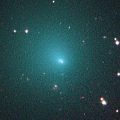
|
Bright new comet. Now it is very bright as 10.5 mag (Sept. 19, Katsumi Yoshimoto). It stays 10 mag until November. In the Southern Hemisphere, it stays observable in good condition for a while. In the Northern Hemisphere, it becomes low rapidly.
Date(TT) R.A. (2000) Decl. Delta r Elong. m1 Best Time(A, h)
Sept.24 0 27.61 -25 53.0 0.851 1.804 153 10.3 0:21 ( 0, 30)
Oct. 1 23 27.73 -34 18.0 0.875 1.764 140 10.1 22:42 ( 0, 20)
|
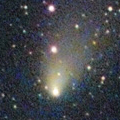
|
It brightened up to 10.4 mag from June to July (July 22, Ken-ichi Kadota). Now it is not observable. In the Souther Hemisphere, it will appear in the morning sky at 12 mag in October. It will never be observable again in the Northern Hemisphere.
Date(TT) R.A. (2000) Decl. Delta r Elong. m1 Best Time(A, h)
Sept.24 12 4.53 -27 55.4 2.212 1.403 27 11.2 19:18 ( 76,-32)
Oct. 1 12 21.84 -32 28.7 2.260 1.474 29 11.5 4:30 (290,-32)
|
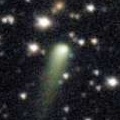
|
Now it is bright as 11.9 mag (Sept. 17, Chris Wyatt). It will approach to Earth down to 0.29 a.u. in 2023 February, and it is expected to brighten up to 5 mag. In the Northern Hemisphere, it stays observable in excellent condition. In the Southern Hemisphere, it becomes unobservable from October to early February.
Date(TT) R.A. (2000) Decl. Delta r Elong. m1 Best Time(A, h)
Sept.24 16 0.74 28 57.4 2.250 2.020 63 11.8 19:18 ( 97, 45)
Oct. 1 15 56.50 27 56.1 2.257 1.940 58 11.6 19:08 ( 99, 41)
|
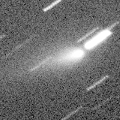
|
Now it is 12.6 mag (Sept. 19, Chris Wyatt). It stays 11-12 mag to autumn. It stays observable in good condition in the Southern Hemisphere. It locates low in the Northern Hemisphere. Michael Jager detected several fragments at 17.5-19 mag.
Date(TT) R.A. (2000) Decl. Delta r Elong. m1 Best Time(A, h)
Sept.24 16 4.55 -31 12.4 0.966 1.059 65 11.8 19:18 ( 42, 8)
Oct. 1 16 47.12 -33 50.2 0.976 1.101 67 12.1 19:08 ( 36, 9)
|

|
It brightened up to 8.3 mag in winter (Jan. 6, Toshiyuki Takahashi). Now it is fading. It has already faded down to 13.3 mag (Sept. 4, N. Paul, B. Lutkenhoner, E. Cortes). Appering in the morning sky.
Date(TT) R.A. (2000) Decl. Delta r Elong. m1 Best Time(A, h)
Sept.24 9 26.57 -9 59.0 4.961 4.240 39 11.9 4:24 (288, 8)
Oct. 1 9 32.03 -11 26.0 4.933 4.274 44 12.0 4:30 (294, 12)
|
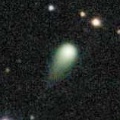
|
Now it is 12.4 mag (Sept. 16, S. Shurpakov). It is expected to brighten up to 10 mag in 2023. In the Northern Hemisphere, it stays observable in good condition until 2023 autumn, although it became very low temporarily in summer. In the Southern Hemipshere, it stays unobservable until 2023 summer.
Date(TT) R.A. (2000) Decl. Delta r Elong. m1 Best Time(A, h)
Sept.24 10 40.17 53 45.1 3.796 3.351 56 12.1 4:24 (222, 27)
Oct. 1 10 45.41 54 27.0 3.660 3.297 61 12.0 4:30 (223, 31)
|

|
The condition is worst in this apparition. It is not observable at all.
Date(TT) R.A. (2000) Decl. Delta r Elong. m1 Best Time(A, h)
Sept.24 13 15.18 -2 47.2 1.964 1.060 18 12.3 19:18 ( 89, -5)
Oct. 1 13 43.89 -5 25.0 1.971 1.077 19 12.5 19:08 ( 86, -4)
|
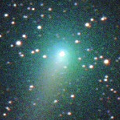
|
It brightened up to 9.3 mag in early summer (June 5, Chris Wyatt). Now it is fading. It has already faded down to 12.8 mag (Aug. 20, Chris Wyatt). In the Southen Hemisphere, it stays observable in good condition for a long time. In the Northern Hemisphere, it is not observable until November when it fades down to 13 mag.
Date(TT) R.A. (2000) Decl. Delta r Elong. m1 Best Time(A, h)
Sept.24 10 11.25 -39 8.4 2.780 2.212 46 12.4 4:24 (306,-17)
Oct. 1 10 12.94 -39 19.1 2.817 2.263 47 12.5 4:30 (310,-12)
|

|
Appearing in the morning sky in the Northern Hemisphere. It will appear in the morning sky in November also in the Southern Hemisphere. It will brighten up to 11.5 mag in winter
Date(TT) R.A. (2000) Decl. Delta r Elong. m1 Best Time(A, h)
Sept.24 10 3.25 11 44.7 2.563 1.791 31 12.6 4:24 (265, 13)
Oct. 1 10 21.52 10 11.4 2.501 1.762 34 12.4 4:30 (268, 15)
|
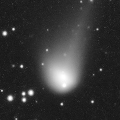
|
Now it is bright as 12.8 mag (Aug. 28, Hiroshi Abe). It stays 12 mag for a while. It becomes unobservable from August to November in the Northern Hemisphere, or from September to December in the Southern Hemisphere.
Date(TT) R.A. (2000) Decl. Delta r Elong. m1 Best Time(A, h)
Sept.24 13 22.63 -3 0.0 5.262 4.335 20 12.6 19:18 ( 89, -3)
Oct. 1 13 30.24 -3 2.2 5.303 4.347 15 12.6 19:08 ( 90, -5)
|
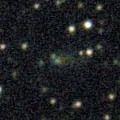
|
Now it is 14.9 mag (Sept. 2, Thomas Lehmann). It is expected to brighten very rapidly up to 11-12 mag in winter, and it will be observable in excellent condition.
Date(TT) R.A. (2000) Decl. Delta r Elong. m1 Best Time(A, h)
Sept.24 6 41.61 12 46.0 1.790 1.902 80 13.5 4:24 (300, 54)
Oct. 1 6 56.25 12 16.2 1.714 1.887 83 13.2 4:30 (306, 57)
|

|
Now it is 13.6 mag (Sept. 19, Chris Wyatt). It is expected to brighten up to 11 mag in 2023. In the Northern Hemisphere, it stays observable in good condition until November. But it becomes unobservable after that. In the Southern Hemisphere, it stays observable in good condition for a long time, although it becomes unobservable temporarily from November to January.
Date(TT) R.A. (2000) Decl. Delta r Elong. m1 Best Time(A, h)
Sept.24 17 15.58 -6 20.4 3.843 3.771 78 13.3 19:18 ( 44, 38)
Oct. 1 17 16.87 -8 1.0 3.918 3.734 72 13.3 19:08 ( 47, 34)
|
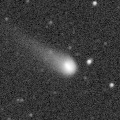
|
Now it is 13.6 mag (Aug. 28, Hiroshi Abe). It is expected to brighten up to 12 mag in 2023. In the Northern Hemisphere, it stays observable in good condition for a long time, although it becomes unobservable temporarily in October. In the Southern Hemisphere, it is not observable until mid December. But it will be observable in good condition in 2023.
Date(TT) R.A. (2000) Decl. Delta r Elong. m1 Best Time(A, h)
Sept.24 13 30.22 17 26.3 4.851 3.993 27 13.5 19:18 (104, 10)
Oct. 1 13 32.25 16 8.9 4.853 3.967 24 13.5 19:08 (105, 6)
|

|
Now it is 13.9 mag (Sept. 6. Ken-ichi Kadota).
Date(TT) R.A. (2000) Decl. Delta r Elong. m1 Best Time(A, h)
Sept.24 6 51.62 28 56.7 6.131 6.026 79 13.8 4:24 (272, 60)
Oct. 1 6 54.27 28 56.7 6.022 6.029 85 13.8 4:30 (278, 67)
|
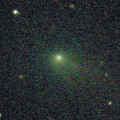
|
Now it is 13.4 mag (Sept. 17, Thomas Lehmann). It stays observable in good condition after this. But it will be fading gradually after this.
Date(TT) R.A. (2000) Decl. Delta r Elong. m1 Best Time(A, h)
Sept.24 1 25.28 0 46.2 1.396 2.361 159 13.9 1:16 ( 0, 56)
Oct. 1 1 18.90 0 0.9 1.418 2.403 166 14.1 0:42 ( 0, 55)
|

|
Now it is 13.7 mag (Sept. 17, Thomas Lehmann). It stays observable at 13-14 mag for a while.
Date(TT) R.A. (2000) Decl. Delta r Elong. m1 Best Time(A, h)
Sept.24 18 40.00 -31 25.9 2.761 3.064 97 14.0 19:18 ( 12, 23)
Oct. 1 18 46.09 -31 10.6 2.859 3.069 92 14.0 19:08 ( 14, 22)
|
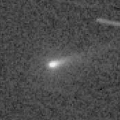
|
Bright new comet. Now it is bright as 14.3 mag (Sept. 23, Michael Jager). Although it is a tiny comet, it will approach to Sun down to 0.63 a.u. on Oct. 25. In the Northern Hemisphere, it is observable until late October. In the Southern Hemisphere, it is not observable after this.
Date(TT) R.A. (2000) Decl. Delta r Elong. m1 Best Time(A, h)
Sept.24 8 54.73 25 36.4 1.055 0.905 52 14.7 4:24 (261, 34)
Oct. 1 9 56.41 27 14.5 1.020 0.811 47 14.1 4:30 (256, 29)
|
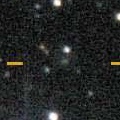
|
Now it is 16.3 mag (Sept. 15, ATLAS-HKO, Haleakala). It is expected to brighten up to 12 mag from winter to summer in 2023. In the Northern Hemisphere, it stays observable in good condition until 2023 spring. In the Southern Hemisphere, it stays observable in good condition for a long time after this. It is fainter than this ephemeris recently.
Date(TT) R.A. (2000) Decl. Delta r Elong. m1 Best Time(A, h)
Sept.24 5 16.49 33 4.2 2.906 3.230 99 14.4 4:24 (279, 81)
Oct. 1 5 16.97 31 57.5 2.740 3.173 106 14.2 4:30 (325, 86)
|

|
Now it is 14.3 mag (Aug. 31, Ken-ichi Kadota). The brightness evolution is slower than originally expected. It stays 14-15 mag for a long time. It locates extremely low in the Northern Hemisphere. In the Southern Hemisphere, it will be unobservable temporarily in November.
Date(TT) R.A. (2000) Decl. Delta r Elong. m1 Best Time(A, h)
Sept.24 16 42.95 -31 2.1 3.091 2.957 72 14.3 19:18 ( 36, 13)
Oct. 1 16 44.88 -29 8.6 3.218 2.960 66 14.4 19:08 ( 40, 13)
|
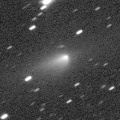
|
Now it is 13.8 mag (Aug. 20, Chris Wyatt). It is already unobservable in the Northern Hemisphere. It will be unobservable soon also in the Southern Hemisphere.
Date(TT) R.A. (2000) Decl. Delta r Elong. m1 Best Time(A, h)
Sept.24 13 38.79 -11 6.2 3.105 2.250 26 14.8 19:18 ( 79, -5)
Oct. 1 13 52.85 -12 30.9 3.147 2.261 23 14.8 19:08 ( 79, -6)
|

|
Now it is 14.9 mag (Sept. 4, ATLAS South Africa). It was expected to brighten up to 13 mag in spring. But actually, it is fainter than originally expected. In the Southern Hemisphere, it stays observable in good condition for a long time. In the Northern Hemisphere, it stays extremely low for a while.
Date(TT) R.A. (2000) Decl. Delta r Elong. m1 Best Time(A, h)
Sept.24 6 28.36 -47 29.1 3.197 3.273 85 15.2 4:24 (341, 4)
Oct. 1 6 19.03 -48 54.9 3.153 3.294 89 15.2 4:30 (348, 5)
|
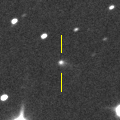
|
Now it is 15.8 mag (Aug. 31, Ken-ichi Kadota). It will brighten up to 14 mag in early 2023, and it will be observable in good condition.
Date(TT) R.A. (2000) Decl. Delta r Elong. m1 Best Time(A, h)
Sept.24 8 18.93 16 48.0 4.045 3.608 57 15.4 4:24 (275, 37)
Oct. 1 8 27.62 16 41.7 3.938 3.585 62 15.3 4:30 (279, 42)
|
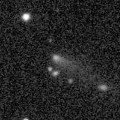
|
Now it is 15.3 mag (Sept. 6, Ken-ichi Kadota). It stays 15 mag and observable in excellent condition until December.
Date(TT) R.A. (2000) Decl. Delta r Elong. m1 Best Time(A, h)
Sept.24 2 51.29 15 29.0 1.620 2.440 135 15.4 2:42 ( 0, 71)
Oct. 1 2 49.39 16 41.5 1.561 2.433 142 15.3 2:13 ( 0, 72)
|
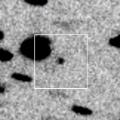
|
Now it is 16.4 mag (Sept. 13, ATLAS South Africa). Now it is fading. It stays 13-14 mag for a while. It is observable in excellent condition in the Southern Hemisphere. It locates somewhat low in the Northern Hemisphere.
Date(TT) R.A. (2000) Decl. Delta r Elong. m1 Best Time(A, h)
Sept.24 22 21.13 -28 13.6 1.505 2.382 142 15.4 22:08 ( 0, 27)
Oct. 1 22 18.36 -27 40.9 1.597 2.422 136 15.7 21:38 ( 0, 27)
|
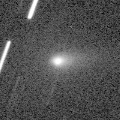
|
Now it is 14.0 mag (Sept. 22, Michael Jager). It brightened rapidly as predicted. It will be fading after this, and it will be fainter than 18 mag in December.
Date(TT) R.A. (2000) Decl. Delta r Elong. m1 Best Time(A, h)
Sept.24 2 11.01 -16 6.7 0.644 1.572 144 15.5 2:01 ( 0, 39)
Oct. 1 2 14.88 -22 15.9 0.662 1.584 143 15.6 1:38 ( 0, 33)
|
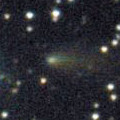
|
Now it is 15.3 mag (Sept. 16, ATLAS-HKO, Haleakala). It stays observable in good condition at 15 mag from summer to winter. It locates somwwhat low in the Southern Hemisphere.
Date(TT) R.A. (2000) Decl. Delta r Elong. m1 Best Time(A, h)
Sept.24 7 4.83 19 38.6 2.390 2.347 75 15.6 4:24 (285, 53)
Oct. 1 7 15.60 19 30.4 2.317 2.354 79 15.5 4:30 (290, 58)
|
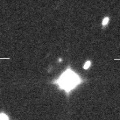
|
It is expected to brighten up to 12.5 mag in winter. In the Northern Hemisphere, it will become observable in October. Then it stays observable in good condition after that. In the Southern Hemisphere, it is not observable until 2023 June.
Date(TT) R.A. (2000) Decl. Delta r Elong. m1 Best Time(A, h)
Sept.24 11 44.32 16 40.0 3.475 2.536 17 15.7 4:24 (246, -4)
Oct. 1 11 52.88 17 20.0 3.376 2.477 22 15.6 4:30 (250, 1)
|
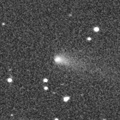
|
Now it is 15.6 mag (Sept. 6, Ken-ichi Kadota). It stays 15.5 mag until November, and it stays observable in good condition.
Date(TT) R.A. (2000) Decl. Delta r Elong. m1 Best Time(A, h)
Sept.24 1 36.71 4 10.7 1.182 2.138 156 15.7 1:27 ( 0, 59)
Oct. 1 1 34.50 3 22.1 1.154 2.133 163 15.6 0:58 ( 0, 59)
|
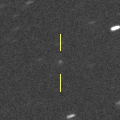
|
It will brighten up to 13 mag in winter. But the condition is bad. It is not observable until February in the Southern Hemisphere, or until May in the Northern Hemisphere.
Date(TT) R.A. (2000) Decl. Delta r Elong. m1 Best Time(A, h)
Sept.24 13 8.80 -3 28.1 2.878 1.940 16 15.9 19:18 ( 90, -6)
Oct. 1 13 23.67 -5 18.3 2.861 1.906 14 15.7 19:08 ( 89, -8)
|

|
Now it is 16.5 mag (Aug. 17, Thomas Lehmann). It stays at 15-16 mag for a long time. In the Southern Hemisphere, it stays observable in excellent condition for a long time, although it becomes extremely low temporarily in November. In the Northern Hemiphere, it is not observable after this.
Date(TT) R.A. (2000) Decl. Delta r Elong. m1 Best Time(A, h)
Sept.24 14 27.21 -49 22.1 6.039 5.574 58 15.9 19:18 ( 41,-18)
Oct. 1 14 29.74 -49 40.7 6.136 5.598 53 15.9 19:08 ( 42,-20)
|
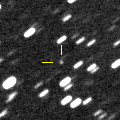
|
Now it is 15.4 mag (Sept. 16, ATLAS-MLO, Mauna Loa). It will brighten up to 14 mag in 2023. In the Southern Hemisphere, it stays observable in good condition for a long time. It locates somewhat low in the Northern Hemisphere.
Date(TT) R.A. (2000) Decl. Delta r Elong. m1 Best Time(A, h)
Sept.24 6 37.62 -15 13.0 3.994 3.970 81 16.0 4:24 (324, 32)
Oct. 1 6 34.04 -16 14.2 3.846 3.934 87 15.9 4:30 (334, 35)
|
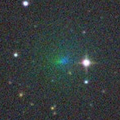
|
Brightened rapidly. It brightened up to 14.0 mag in early September (Sept. 2, Michael Jager). Now it is 16.4 mag (Sept. 10, Ken-ichi Kadota). It will be fading after this. In the Northern Hemisphere, it stays observable for a long time, although it becomes extremely low in November. In the Southern Hemisphere, it becomes unobservable soon.
Date(TT) R.A. (2000) Decl. Delta r Elong. m1 Best Time(A, h)
Sept.24 15 23.48 16 38.4 1.993 1.593 52 16.0 19:18 ( 88, 32)
Oct. 1 15 20.50 16 52.2 2.095 1.592 47 16.1 19:08 ( 91, 28)
|
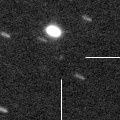
|
Now it is 16.0 mag (Sept. 16, ATLAS-MLO, Mauna Loa). It is expected to brighten up to 8 mag in 2023 July. In 2022, it stays observable in good condition while the comet will be brightening gradually.
Date(TT) R.A. (2000) Decl. Delta r Elong. m1 Best Time(A, h)
Sept.24 3 12.00 0 57.9 3.328 4.074 132 16.2 3:03 ( 0, 56)
Oct. 1 3 4.00 -0 21.9 3.181 4.007 140 16.0 2:27 ( 0, 55)
|
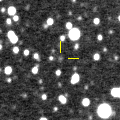
|
Now it is 16.8 mag (June 1, ATLAS South Africa). It will brighten up to 13 mag from 2024 to 2025.
Date(TT) R.A. (2000) Decl. Delta r Elong. m1 Best Time(A, h)
Sept.24 8 49.10 -28 17.3 7.825 7.280 53 16.2 4:24 (308, 3)
Oct. 1 8 53.18 -28 58.2 7.740 7.245 57 16.1 4:30 (313, 7)
|
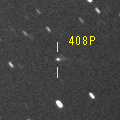
|
Now it is 16.6 mag (Sept. 10, Ken-ichi Kadota). It will be observable at 16-17 mag in excellent condition from autumn to winter.
Date(TT) R.A. (2000) Decl. Delta r Elong. m1 Best Time(A, h)
Sept.24 4 36.12 6 8.1 2.973 3.468 111 16.4 4:24 (359, 61)
Oct. 1 4 37.82 5 22.0 2.889 3.468 117 16.3 4:00 ( 0, 60)
|
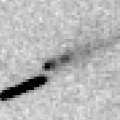
|
Now it is 16.1 mag (Sept. 23, Michael Jager). It stays observable at 16 mag from summer to winter. In the Southern Hemisphere, it locates low until October. Michael Jager discovered a 18-mag fragment.
Date(TT) R.A. (2000) Decl. Delta r Elong. m1 Best Time(A, h)
Sept.24 8 27.94 22 3.0 1.888 1.579 56 16.4 4:24 (268, 38)
Oct. 1 8 46.95 20 9.9 1.854 1.587 58 16.3 4:30 (272, 40)
|
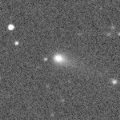
|
Now it is 15.9 mag (Sept. 5, Michael Jager). It continued brightening even after the perihelion passage. It stays observable at 16 mag in good condition for a while.
Date(TT) R.A. (2000) Decl. Delta r Elong. m1 Best Time(A, h)
Sept.24 23 5.93 -2 4.5 3.316 4.296 165 16.5 22:53 ( 0, 53)
Oct. 1 23 3.08 -2 27.4 3.362 4.308 158 16.5 22:22 ( 0, 53)
|
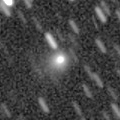
|
It brightened by 6 mag in outburst up to 14.6 mag (Aug. 13, ATLAS-MLO, Mauna Loa). Now it is fading. But it is bright as 15.5 mag still now (Sept. 4, ATLAS-MLO, Mauna Loa). It stays observable in good condition for a while.
Date(TT) R.A. (2000) Decl. Delta r Elong. m1 Best Time(A, h)
Sept.24 18 40.43 3 9.5 1.624 2.046 99 16.5 19:18 ( 23, 56)
Oct. 1 18 48.55 1 26.6 1.652 2.010 95 16.7 19:08 ( 25, 54)
|

|
It brightened up to 14 mag in 2021. Now it is fading. It has already faded down to 16.1 mag (Sept. 8, ATLAS-MLO, Mauna Loa). It is observable at 16-17 mag in 2022.
Date(TT) R.A. (2000) Decl. Delta r Elong. m1 Best Time(A, h)
Sept.24 23 39.95 15 14.3 5.189 6.160 164 16.5 23:27 ( 0, 70)
Oct. 1 23 35.74 15 15.9 5.236 6.197 162 16.5 22:55 ( 0, 70)
|
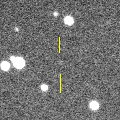
|
Now it is 16.1 mag (Sept. 13, J.-C. Merlin). It is expected to brighten up to 7 mag in early 2024. In the Southern Hemisphere, it stays observable in good condition for a long time. In the Northern Hemisphere, it stays low in 2022.
Date(TT) R.A. (2000) Decl. Delta r Elong. m1 Best Time(A, h)
Sept.24 6 17.85 -26 20.7 5.948 5.970 86 16.6 4:24 (335, 24)
Oct. 1 6 19.50 -27 23.8 5.816 5.908 90 16.5 4:30 (342, 25)
|

|
Now it is 15.6 mag (Sept. 8, ATLAS-MLO, Mauna Loa). It brightened up to 14 mag from 2020 to 2021. Now it is fading slowly. It is observable at 16-17 mag in 2022.
Date(TT) R.A. (2000) Decl. Delta r Elong. m1 Best Time(A, h)
Sept.24 0 31.04 -19 30.0 3.007 3.960 159 16.6 0:22 ( 0, 36)
Oct. 1 0 26.30 -19 49.8 3.036 3.978 157 16.6 23:45 ( 0, 35)
|
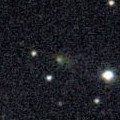
|
Now it is 17.0 mag (Sept. 1, ATLAS-MLO, Mauna Loa). It will be observable at 16-17 mag in good condition from summer to autumn.
Date(TT) R.A. (2000) Decl. Delta r Elong. m1 Best Time(A, h)
Sept.24 3 41.75 27 27.1 1.735 2.409 120 16.6 3:32 ( 0, 83)
Oct. 1 3 42.02 27 38.1 1.690 2.433 127 16.6 3:05 ( 0, 83)
|
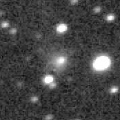
|
Now it is 16.7 mag (Sept. 4, Purple Mountain Observatory). It stayed bright for a while even after the perihelion passage, but it will be fading after this. It will be fainter than 18 mag in winter.
Date(TT) R.A. (2000) Decl. Delta r Elong. m1 Best Time(A, h)
Sept.24 21 25.31 4 25.2 6.336 7.140 140 16.9 21:12 ( 0, 59)
Oct. 1 21 22.11 3 26.3 6.437 7.166 133 16.9 20:42 ( 0, 58)
|

|
It brightened up to 14.2 mag in 2021 summer (July 18, 2021, Taras Prystavski). Now it is fading. It has already faded down to 16.8 mag (Sept. 12, ATLAS Chile). In the Southern Hemisphere, it stays observable in good condition for a long time. It locates somewhat low in the Northern Hemisphere.
Date(TT) R.A. (2000) Decl. Delta r Elong. m1 Best Time(A, h)
Sept.24 2 2.55 -27 0.5 4.563 5.373 140 16.9 1:53 ( 0, 28)
Oct. 1 1 57.64 -27 2.2 4.583 5.416 142 16.9 1:21 ( 0, 28)
|
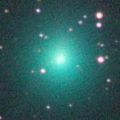
|
It brightened up to 9.3 mag from spring to early summer (Mar. 24, Michael Jager). It stayed bright for a while even after the perihelion passaage. But it is fading rapidly now. It has already faded down to 17.1 mag (Aug. 9, iTelescope Observatory, Siding Spring). However, Thomas Lehmann reported it is bright as 13.8 mag on Sept. 2. In the Southern Hemisphere, it stays observable in good condition for a long time. In the Northern Hemisphere, it will never be observable again.
Date(TT) R.A. (2000) Decl. Delta r Elong. m1 Best Time(A, h)
Sept.24 5 40.52 -75 34.5 2.510 2.721 91 16.9 4:24 (356,-21)
Oct. 1 5 40.99 -78 42.9 2.629 2.803 89 17.3 4:30 (358,-24)
|
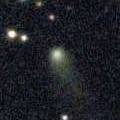
|
Now it is 16.1 mag (Sept. 16, S. Shurpakov). It stays observable at 16 mag from 2021 to 2022. It locates low in the Southern Hemisphere.
Date(TT) R.A. (2000) Decl. Delta r Elong. m1 Best Time(A, h)
Sept.24 15 47.08 38 45.3 5.831 5.474 64 17.0 19:18 (112, 46)
Oct. 1 15 52.51 38 25.5 5.887 5.501 62 17.0 19:08 (112, 43)
|

|
Now it is 16.5 mag (Sept. 7, ATLAS-MLO, Mauna Loa). Fading slowly. In the Northern Hemisphere, it stays observable in good condition for a long time. In the Southern Hemisphere, it is not observable after this.
Date(TT) R.A. (2000) Decl. Delta r Elong. m1 Best Time(A, h)
Sept.24 17 8.77 65 3.5 9.443 9.402 84 17.0 19:18 (156, 53)
Oct. 1 17 8.78 64 36.4 9.461 9.416 84 17.1 19:08 (153, 52)
|
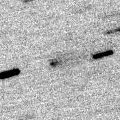
|
Now it is 16.9 mag (Aug. 31, Michael Jager). It stays observable at 17 mag until winter. In the Southern Hemisphere, it locates extremely low until autumn.
Date(TT) R.A. (2000) Decl. Delta r Elong. m1 Best Time(A, h)
Sept.24 8 29.04 20 59.7 2.493 2.107 56 17.2 4:24 (269, 37)
Oct. 1 8 42.33 19 43.5 2.449 2.128 59 17.2 4:30 (273, 41)
|
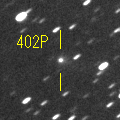
|
It brightened up to 15.3 mag in last winter (Jan. 12, H. Nohara). Now it is fading. It will be observable at 17 mag in good condition in next winter. It locates somewhat low in the Southern Hemisphere.
Date(TT) R.A. (2000) Decl. Delta r Elong. m1 Best Time(A, h)
Sept.24 9 28.35 18 21.7 4.942 4.251 42 17.3 4:24 (264, 24)
Oct. 1 9 35.45 18 16.6 4.880 4.266 47 17.3 4:30 (267, 29)
|
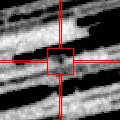
|
Now it is 17.0 mag (Sept. 12, E. Bryssinck). It is expected to brighten up to 11-12 mag in 2024. In the Northern Hemisphere, it stays observable in good condition for a long time until 2023 autumn, although it becomes temporarily low in December. In the Southern Hemisphere, it becomes unobservable in October. But it will be observable in excellent condition at the high light.
Date(TT) R.A. (2000) Decl. Delta r Elong. m1 Best Time(A, h)
Sept.24 17 58.72 25 24.3 5.691 5.766 89 17.4 19:18 ( 70, 68)
Oct. 1 17 57.00 24 15.6 5.727 5.715 84 17.4 19:08 ( 73, 64)
|

|
Now it is 17.5 mag (Sept. 10, Ken-ichi Kadota). It stays observable at 17-18 mag in 2022. It locates somewhat low in the Southern Hemisphere.
Date(TT) R.A. (2000) Decl. Delta r Elong. m1 Best Time(A, h)
Sept.24 2 2.14 28 39.2 4.695 5.499 139 17.4 1:53 ( 0, 84)
Oct. 1 1 52.70 28 6.1 4.638 5.511 147 17.4 1:16 ( 0, 83)
|

|
It brightened very rapidly up to 15.5 mag from last autumn to last winter (Nov. 2, 2021, Toshihiko Ikemura, Hirohisa Sato). Now it is fading. It has already faded down to 17.1 mag (Sept. 13, J.-C. Merlin).
Date(TT) R.A. (2000) Decl. Delta r Elong. m1 Best Time(A, h)
Sept.24 6 37.32 14 6.6 4.243 4.215 81 17.4 4:24 (299, 55)
Oct. 1 6 41.15 13 40.2 4.157 4.232 87 17.4 4:30 (309, 60)
|
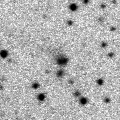
|
Now it is 17.9 mag (Sept. 12, E. Bryssinck). It started fading before the perihelion passage. It was predicted to stay at 16 mag for a long time. But actually, it will be fainter than 18 mag in autumn. In the Northern Hemisphere, it stays observable in good condition for a long time. In the Southern Hemisphere, it is not observable until 2023.
Date(TT) R.A. (2000) Decl. Delta r Elong. m1 Best Time(A, h)
Sept.24 17 31.74 55 53.8 3.923 3.980 85 17.4 19:18 (145, 61)
Oct. 1 17 37.37 53 6.2 3.963 4.000 84 17.5 19:08 (138, 61)
|
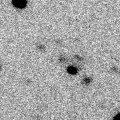
|
Now it is 17.3 mag (Sept. 17, Catalina Sky Survey). In the Northern Hemisphere, it stays observable at 17 mag in good condition for a long time until winter. In the Southern Hemisphere, it stays extremely low for a long time.
Date(TT) R.A. (2000) Decl. Delta r Elong. m1 Best Time(A, h)
Sept.24 7 2.31 45 32.9 2.805 2.806 79 17.5 4:24 (238, 60)
Oct. 1 7 15.27 45 58.7 2.742 2.818 83 17.4 4:30 (236, 64)
|
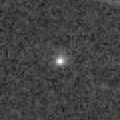
|
Now it is 16.7 mag (Sept. 22, Michael Jager). It stays observable at 17-18 mag until next summer. It may be brighter than this ephemeris.
Date(TT) R.A. (2000) Decl. Delta r Elong. m1 Best Time(A, h)
Sept.24 1 46.56 -7 51.9 1.378 2.316 152 17.8 1:38 ( 0, 47)
Oct. 1 1 13.33 -10 6.7 1.283 2.258 162 17.6 0:38 ( 0, 45)
|

|
It approached to Sun down to 0.14 a.u. on May 15. But it was not observable around that time. In the Northern Hemisphere, it stays observable at 17-18 mag in good condition from July to November. In the Southern Hemisphere, it stays extremely low.
Date(TT) R.A. (2000) Decl. Delta r Elong. m1 Best Time(A, h)
Sept.24 3 46.89 45 45.4 1.376 1.995 113 17.7 3:38 (180, 79)
Oct. 1 3 32.04 46 13.7 1.335 2.040 121 17.6 2:56 (180, 79)
|
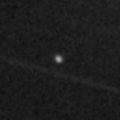
|
Now it is 17.4 mag (Aug. 9, Michael Jager). In 2022, it stays observable at 17 mag for a long time.
Date(TT) R.A. (2000) Decl. Delta r Elong. m1 Best Time(A, h)
Sept.24 7 13.80 25 27.1 0.698 1.053 74 17.7 4:24 (275, 55)
Oct. 1 7 31.84 24 27.3 0.726 1.093 76 17.7 4:30 (279, 57)
|
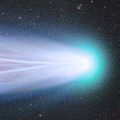
|
It brightened up to 3 mag from mid December to late December. Now it is fading. It is observable in good condition in the Southern Hemisphere. No observations have been reported since June.
Date(TT) R.A. (2000) Decl. Delta r Elong. m1 Best Time(A, h)
Sept.24 16 6.20 -21 37.1 4.353 4.000 63 17.7 19:18 ( 49, 15)
Oct. 1 16 9.55 -21 26.1 4.537 4.078 56 17.9 19:08 ( 51, 13)
|
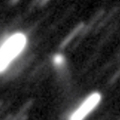
|
Now it is 16.8 mag (Sept. 14, ATLAS-MLO, Mauna Loa). It was observed at 15 mag in 2021. Now it is fading. It stays observable at 16-17 mag for a while in 2022.
Date(TT) R.A. (2000) Decl. Delta r Elong. m1 Best Time(A, h)
Sept.24 17 46.35 28 47.4 5.690 5.719 86 17.7 19:18 ( 82, 67)
Oct. 1 17 48.32 28 28.2 5.785 5.747 82 17.8 19:08 ( 84, 64)
|
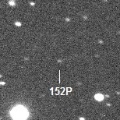
|
Now it is 17.9 mag (Sept. 2, J. Drummond). It will be fading gradually after this. It locates somewhat low in the Northern Hemisphere.
Date(TT) R.A. (2000) Decl. Delta r Elong. m1 Best Time(A, h)
Sept.24 19 23.15 -28 21.9 2.931 3.373 107 17.7 19:18 ( 2, 27)
Oct. 1 19 26.88 -28 14.3 3.041 3.387 101 17.9 19:08 ( 5, 27)
|
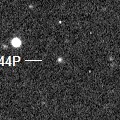
|
It is observable at 17 mag in good condition in winter. It locates somewhat low in the Southern Hemisphere.
Date(TT) R.A. (2000) Decl. Delta r Elong. m1 Best Time(A, h)
Sept.24 6 19.26 25 39.4 3.861 3.926 86 17.9 4:24 (285, 66)
Oct. 1 6 23.56 25 41.2 3.757 3.925 92 17.8 4:30 (294, 71)
|

|
Now it is 17.5 mag (Aug. 25, C. Gerhard). In the Northern Hemisphere, it is observable at 17-18 mag in excellent condition in autumn. In the Southern Hemisphere, it is only observable in extremely low sky in September.
Date(TT) R.A. (2000) Decl. Delta r Elong. m1 Best Time(A, h)
Sept.24 7 14.96 38 54.9 2.691 2.637 76 17.9 4:24 (251, 58)
Oct. 1 7 25.40 41 9.6 2.618 2.656 81 17.8 4:30 (247, 62)
|
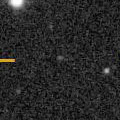
|
Now it is 17.3 mag (Sept. 16, ATLAS-MLO, Mauna Loa). It stays observable at 18 mag in good condition from August to September.
Date(TT) R.A. (2000) Decl. Delta r Elong. m1 Best Time(A, h)
Sept.24 23 39.05 -9 7.2 1.348 2.341 168 17.8 23:26 ( 0, 46)
Oct. 1 23 35.24 -9 2.1 1.375 2.349 162 17.9 22:54 ( 0, 46)
|
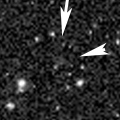
|
Now it is 17.3 mag (June 27, ATLAS South Africa). Very far object. It stays 18 mag for a long time from 2021 to 2026. In the Southern Hemisphere, it stays observable in good condition for a long time. In the Northern Hemisphere, it is not observable at all.
Date(TT) R.A. (2000) Decl. Delta r Elong. m1 Best Time(A, h)
Sept.24 8 19.88 -66 53.1 10.732 10.551 76 17.9 4:24 (340,-20)
Oct. 1 8 20.94 -67 39.1 10.727 10.543 76 17.9 4:30 (343,-19)
|
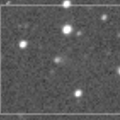
|
It was observed at 17 mag in 2021. It was expected to be observable at 17-18 mag also in 2022. But actually, it is much fainter than last year by 3 mag, 20.3 mag (Sept. 5, W. Hasubick).
Date(TT) R.A. (2000) Decl. Delta r Elong. m1 Best Time(A, h)
Sept.24 2 51.59 13 12.1 2.758 3.550 136 19.7 2:42 ( 0, 68)
Oct. 1 2 47.01 13 49.1 2.714 3.572 143 19.7 2:10 ( 0, 69)
|
|
![]()
 C/2021 E3 ( ZTF )
C/2021 E3 ( ZTF ) 81P/Wild 2
81P/Wild 2 C/2019 T4 ( ATLAS )
C/2019 T4 ( ATLAS ) 118P/Shoemaker-Levy 4
118P/Shoemaker-Levy 4 C/2020 K1 ( PanSTARRS )
C/2020 K1 ( PanSTARRS ) C/2019 U5 ( PanSTARRS )
C/2019 U5 ( PanSTARRS ) 29P/Schwassmann-Wachmann 1
29P/Schwassmann-Wachmann 1 22P/Kopff
22P/Kopff 117P/Helin-Roman-Alu 1
117P/Helin-Roman-Alu 1 C/2022 R2 ( ATLAS )
C/2022 R2 ( ATLAS ) C/2021 Y1 ( ATLAS )
C/2021 Y1 ( ATLAS ) C/2020 R7 ( ATLAS )
C/2020 R7 ( ATLAS ) 116P/Wild 4
116P/Wild 4 C/2020 Y2 ( ATLAS )
C/2020 Y2 ( ATLAS ) C/2020 S4 ( PanSTARRS )
C/2020 S4 ( PanSTARRS ) P/2022 L3 ( ATLAS )
P/2022 L3 ( ATLAS ) 9P/Tempel 1
9P/Tempel 1 327P/Van Ness
327P/Van Ness 119P/Parker-Hartley
119P/Parker-Hartley C/2022 A2 ( PanSTARRS )
C/2022 A2 ( PanSTARRS ) 61P/Shajn-Schaldach
61P/Shajn-Schaldach 71P/Clark
71P/Clark C/2018 U1 ( Lemmon )
C/2018 U1 ( Lemmon ) C/2021 X1 ( Maury-Attard )
C/2021 X1 ( Maury-Attard ) C/2022 L1 ( Catalina )
C/2022 L1 ( Catalina ) C/2021 T4 ( Lemmon )
C/2021 T4 ( Lemmon ) C/2021 G2 ( ATLAS )
C/2021 G2 ( ATLAS ) 408P/2020 M7 ( Novichonok-Gerke )
408P/2020 M7 ( Novichonok-Gerke ) 157P/Tritton
157P/Tritton 395P/2020 H1 ( Catalina-NEAT )
395P/2020 H1 ( Catalina-NEAT ) 285P/LINEAR
285P/LINEAR C/2020 F5 ( MASTER )
C/2020 F5 ( MASTER ) C/2021 S3 ( PanSTARRS )
C/2021 S3 ( PanSTARRS ) 246P/NEAT
246P/NEAT 44P/Reinmuth 2
44P/Reinmuth 2 C/2019 T3 ( ATLAS )
C/2019 T3 ( ATLAS ) C/2019 F1 ( ATLAS-Africano )
C/2019 F1 ( ATLAS-Africano ) C/2021 F1 ( Lemmon-PanSTARRS )
C/2021 F1 ( Lemmon-PanSTARRS ) C/2020 H6 ( ATLAS )
C/2020 H6 ( ATLAS ) C/2019 O3 ( Palomar )
C/2019 O3 ( Palomar ) P/2022 P2 ( ZTF )
P/2022 P2 ( ZTF ) 402P/2020 Q3 ( LINEAR )
402P/2020 Q3 ( LINEAR ) C/2022 L2 ( ATLAS )
C/2022 L2 ( ATLAS ) C/2020 U4 ( PanSTARRS )
C/2020 U4 ( PanSTARRS ) P/2021 N2 ( Fuls )
P/2021 N2 ( Fuls ) C/2020 U5 ( PanSTARRS )
C/2020 U5 ( PanSTARRS ) C/2021 QM45 ( PanSTARRS )
C/2021 QM45 ( PanSTARRS ) C/2022 Q2 ( ATLAS )
C/2022 Q2 ( ATLAS ) (3200) Phaethon
(3200) Phaethon 107P/(4015) Wilson-Harrington
107P/(4015) Wilson-Harrington C/2021 A1 ( Leonard )
C/2021 A1 ( Leonard ) C/2020 O2 ( Amaral )
C/2020 O2 ( Amaral ) 152P/Helin-Lawrence
152P/Helin-Lawrence 244P/Scotti
244P/Scotti C/2022 P3 ( ZTF )
C/2022 P3 ( ZTF ) 442P/2022 G1 ( McNaught )
442P/2022 G1 ( McNaught ) C/2019 E3 ( ATLAS )
C/2019 E3 ( ATLAS ) 422P/2021 L1 ( Christensen )
422P/2021 L1 ( Christensen )![]()






























































